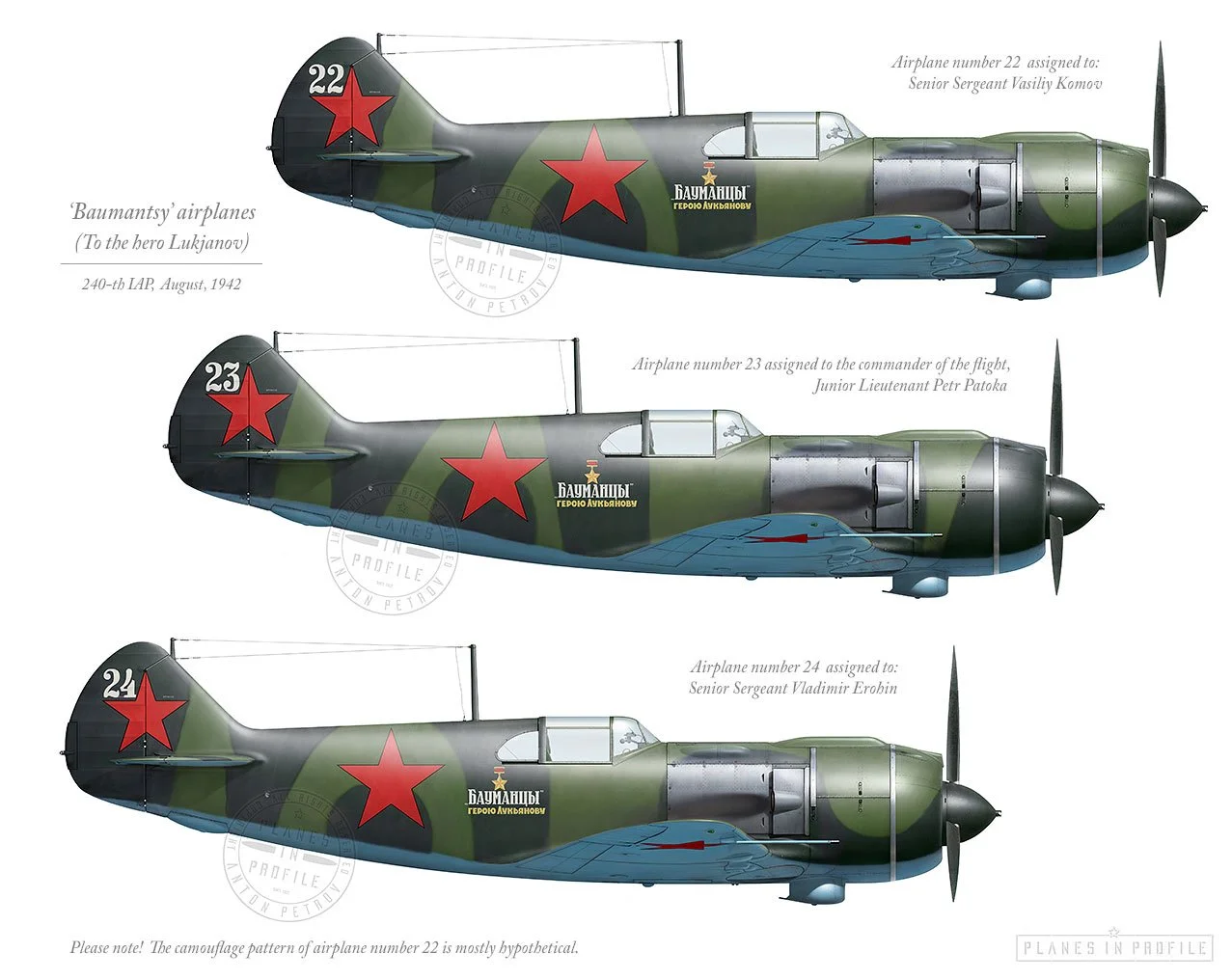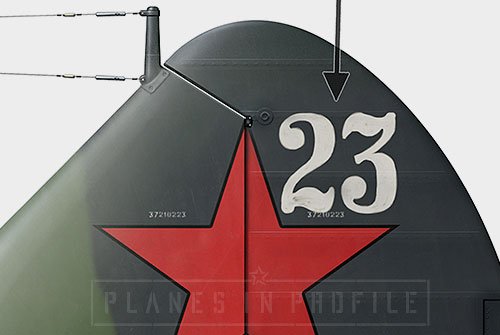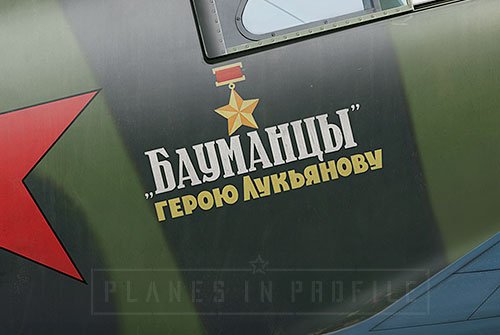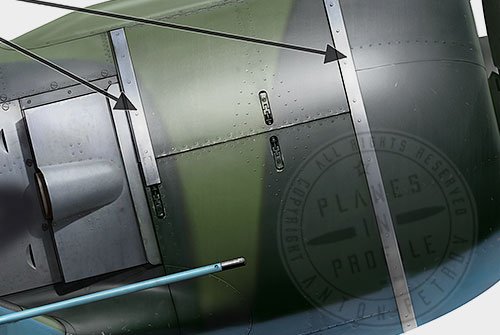Patoka’s White-23 “Baumantsy”
Lavochkin, La-5 (Type 37) (Early)
240th IAP, ‘Baumantsy’ flight, 287th IAD, 8th Air Army, Stalingrad Front, August 1942.
Flown by the commander of the flight, Junior Lieutenant Petr Petrovich Patoka.
The Battle of Stalingrad (23 August 1942 – 2 February 1943) is the first battle where the La-5s started to appear in large numbers. In August 1942 these machines were still very new to both the Soviet pilots as well as to the enemy. The Axis pilots quickly learned to respect the abilities of the La-5, which kept growing with each new La-5 modification.
For the battle of Stalingrad, the Axis threw some of their best air units at the Soviets, including JG3 "Udet", JG52, JG53, KG27, KG1, KG51, KG55, StG1, StG2, etc., Italy sent - Group 21, Romania sent- Group 7. Using this incredible strength, the Luftwaffe pounded Stalingrad with some of the largest bombing raids yet seen in WW2, with the aim of eradicating any resistance and capturing the city quickly. The task of resisting this titanic force fell on the shoulders of poorly trained Soviet boys, flying the machines which they were not accustomed to yet. But as the months of bitter fighting at Stalingrad went by, and despite the horrendous losses of men and equipment on the Soviet side, the Soviet defenders managed to destroy many of Luftwaffe’s Aces, to cripple Luftwaffe’s transport fleet, and to capture an entire enemy army, thus completely upsetting Hitler’s grand plans and turning the tide of war in the east in favour of the Soviets.
In the lead-up to the battle for Stalingrad, the young men of 240th IAP had the honour of receiving three airplanes with an inscription "Baumantsy" - to the hero Lukyanov! Lukyanova Maria Ivanovna who was the mother of H.S.U., A.M.Lukyanov, raised funds from the workers of the factory in the Bauman district of Moscow for the construction of these airplanes.
Based on a video footage of the gifting ceremony held on the 9th of August (and the narrator’s voiceover) , in a solemn atmosphere Mariya Ivanovna said:
’These airplanes carry the name of my Sasha (Sasha is a shortened version of Aleksandr). Be like him. I bless you to do heroic deeds’
Flight commander Patoka in his reply stated:
‘ We swear, that we will strike at the enemy pilots like your son, the hero’
In a book called "Golubye Dali" , I.Y.Sharonchikov describes some more of the ceremony:
“We, the undersigned representatives of the workers of the Bauman district of Moscow, Isaev, Gukov, mother of Hero of the Soviet Union M.I. Lukyanova and representatives of the 240th Fighter Aviation Regiment, Captain Rozhkov, battalion commissar Sled’, junior lieutenant Patoka, drew up this act stating that :
The population of the Bauman district of the capital raised about half a million rubles for the construction of a flight of fighter planes named after the Hero of the Soviet Union A.M. Lukyanov, a pupil of the Bauman district.
This money was used to build three aircraft numbered 22, 23, 24, and today, August 9, 1942, they were transferred to serve with the 240th Fighter Aviation Regiment.
The planes were received by the command of the regiment at a meeting of the unit's personnel.
Aircraft number 22 is assigned to senior sergeant Vasily Komov. Russian, member of the Komsomol. Graduated from the military pilot school in Serpukhov. He flies well. In the battles with the Nazi invaders he showed courage and valor.
Aircraft number 23 was accepted by the commander of the flight, Junior Lieutenant Patoka. Russian, a member of the Komsomol, loves to fly. While taking part in air battles on the Western Front, he proved himself to be a devoted fighter of our socialist Motherland.
Airplane No. 24 was awarded to Senior Sergeant Vladmir Erokhin. An active Komsomol member, he has a great desire to get to the front as soon as possible in order to inflict a mortal blow on the German fascists. "
August 1942 [2] ‘
The serial numbers of these airplanes were most likely 37210222 (Plane number 22), 37210223 (Plane number 23), 37210224 (Plane number 24) [1].
(The image below shows what the planes might have looked like with the tactical numbers painted on. The reconstruction of these numbers is based on a single digit 'number ‘4’ visible on the rudder of White-24.)
The 240th IAP received the ‘Baumantsy’ airplanes at the time when it was retraining to fly the La-5 fighters. The regiment had only three weeks to train to fly the La-5 planes before it arrived at Stalingrad with their new machines and commenced battle service on August 20, 1942. By August 29, 1942, it flew 109 sorties, conducted 58 air battles, shot down 10 aircraft. I was unable to confirm if any of the enemy airplanes were downed by White-23, or any of the other two airplanes.
Due to the enemy’s strength, the 240th IAP was almost completely destroyed during the 10 days of heated fighting. Only a few pilots remained in its ranks, the regiment lost 7 aircraft. The remnants of the regiment were relocated to the rear airfield, and then completely withdrawn to the reserve to undergo restructuring [3].
P. Patoka was one of the survivors. He went on to serve in other regiments after 240th IAP was withdrawn from the Front. He ended his military service in 1957, having earned several medals during his career, including the medal for ‘The Defence of Stalingrad’ , two ‘Order of the Red Star’ medals, and the ‘For Battle Achievements’ medal. [4]
Airplane with the serial number 37210223 (In other words most likely Patoka’s White-23), according to THIS LIST, also survived the battles for the defence of Stalingrad and found its way into the 3d GIAP where it was eventually shot down on the 12.08.43.
240th IAP, having received new pilots, new La-5s, and having been restructured into three squadrons, was back at the Front again in mid March 1943. Among the new pilots was a young man by the name of Kirill Evstigneev, and not long after the regiment received another young pilot whose name was Ivan Kozhedub. These two pilots went on to become two of the world’s greatest fighter Aces of all time.
Noteworthy Visual Characteristics
General) The “Baumantsy” La-5s featured on this page were early series airplanes (Most likely series-02 [1]) and featured all the elements of the early La-5 planes, as listed below. These planes were new during the gifting ceremony on the 9th of August 1942, therefore there was hardly any weathering and paint chipping on them. The regiment was withdrawn from battle action 20 days later, after only about 9-10 days of intense fighting at Stalingrad. So they wouldn’t have had time to ‘age’ very much during that period, in theory .
1) The serial number of Patoka’s plane was most likely 37210223, based on the serial numbers in THIS LINK [1]. 37 represents the ‘type’ of La-5, 21 represents the ‘factory number 21’, 02 represents the ‘series 02 airplane’ and 23 is meant to represent the number of the airplane, usually used as its tactical number. The serial numbers most likely appeared in the usual positions - on the tail and horizontal stabilisers.
2) The tactical number 23 on Patoka’s plane was not factory painted and did not appear on the airplane at the time of the gifting ceremony, as can be seen in this photo reference . Presumably the same goes for numbers 22 and 24 on the other two airplanes, these were painted on later. The only known (To me) photo reference that shows the numbers painted on, is a photo of Plane number 24. And although we can only see digit ‘4’ in the photo, it’s enough to try and reconstruct digits ‘2’ and ‘3’ and determine what the tactical numbers might have looked like.
3) Note the design of the windshield - it’s that of the LaGG-3, typical of the early La-5s. Only the first few series of the La-5s, numbering about 200 planes, were produced with these ‘rounded’ LaGG-3 style windshields.
4) Note the non-standard camouflage on the nose of White-23 airplane. The camo pattern on the nose of White-23 differs from the standard Green/Black camo pattern of the La-5s in that it covers the top of the nose. Video reference of this plane (Stills attached below) seems to show that the camouflage on the nose was the same (or similar) on both sides of the airplane.
This is similar to the camouflage pattern that often appeared on La-5's predecessor - the LaGG-3 airplane.
5) The cowl flap and the small strip of metal in front of it seem to be unpainted (bare metal)
6) ‘БАУМАНЦЫ Герою Лукьянову’ (BAUMANTSY Geroyu Lukyanovu), translates to ‘People of Bauman, To the Hero Lukyanov’ .
This inscription commemorates a 23 year old Hero of the Soviet Union (H.S.U.), fighter ace Aleksandr Mikhailovich Lukyanov, who died on the 28th of January 1942 while defending the motherland. His mother raised the funds from the workers of the factory in the Bauman district of Moscow for the construction of three aircraft. White-23 was one of these three. The “gold” star above the inscription is the image of the H.S.U medal.
In the photo reference we can see a hint of the H.S.U. medal on the left sides of the airplanes, suggesting that the inscription might have been painted on both sides of the fuselage.
However, another photo of what are allegedly the ‘Baumantsy’ airplanes doesn’t seem to show the inscription on the port side (Though it’s worth noting that it is barely visible on the Starboard side too). So whether the inscription was or wasn’t on the left side of the planes is quite questionable.
7) Note the bulged tailwheel doors, these were a leftover design from the LaGG-3. From ‘series 04’ onwards the tail wheel on the La-5 was redesigned to recede completely into the fuselage and the tail wheel doors were therefore made flat.
8) The cowl bands on White-23 look unpainted (bare metal)
9) The warning on the wheel shields might have read ‘Не Вставать’ which loosely translates to ‘Don’t get up (on top of) ’. This seems to have been more common to the early La-5 planes than the other variation of this warning which is ‘Не Становиться’ (loosely translates to ‘Don’t stand on’ ) which was more common to the later La-5 modifications.
10) Note the presence of extra fuel tanks on the wings, marked by ‘10a’ and ‘10b’. Up until ‘series 08’ all La-5s were built with 5 fuel tanks, from ‘series 09’ onwards the number of tanks was reduced down to 3.
11) The camo pattern on the wings might have been more or less similar on both wings, which is different to the standard Green/Black camo pattern. This claim is based on this photo of the ‘Baumantsi’ Airplanes as well as a snippet of a video which reveals the tip of White-23’s left wing, as can be seen in the image below.
12) Note the presence of a ‘trimmer’ on the left aileron, a leftover from the LaGG-3 design. The trimmer was removed on the later series of La-5 airplanes, starting with ‘series 09’.
13) Note the presence of the headlight in the wing.
Here are a few close-up images to help illustrate the points above. Full set of close-up images is On Patreon
Footnotes
[1] I have based the serial numbers on the list in THIS LINK . The list shows serial numbers of four La-5s received by 240th IAP in 1942, three of these were planes number 22, 23, 24, matching the ‘Baumantsy’ airplanes. The date when series-02 planes were produced also matches their August delivery to the regiment. Presuming that the list is correct, these serial numbers should belong to the Baumantsy airplanes. But please note, I have not been able to check this against other sources.
[2] Translated from an article published by Roman Sarychev on Scalemodels.ru http://scalemodels.ru/articles/6935-zvezda-1-48-la-5---kost-v-gorle.html . Roman’s original source is listed as:
I.Y.Sharonchikov "Golubye Dali" , published by Military Publishing House, Moscow, 1964.
[3] This sentence, as well as the dates and figures mentioned in this paragraph, are taken from Russian Wikipedia entry about 240th IAP
[4] This info is taken from Pamyat-naroda.ru
Summary of LINKS TO THE REFERENCE IMAGES AND VIDEOS
Images of Patoka’s White-23 be found in the Russian video called ‘Legendary Airplanes, Part-1’ from 24:06 to 24.54
https://youtu.be/9zjyHmnuDCw?t=1446
Stills can be found on a page dedicated to the Baumantsy planes, created by Massimo Tessitori http://massimotessitori.altervista.org/sovietwarplanes/pages/la5/la5early/240iap.htm
To go directly to some of those images:
Image 1
http://massimotessitori.altervista.org/sovietwarplanes/pages/la5/la5early/total-r.jpg
Image 2
http://massimotessitori.altervista.org/sovietwarplanes/pages/la5/la5early/240iap.jpg
Image 3
http://massimotessitori.altervista.org/sovietwarplanes/pages/la5/la5early/240iap3.jpg
Image 5
Image 6
Image 7
All the work presented on this is page is subject to updates and revisions in the light of new information which might present itself. If you have any new information relevant to this page or disagree with anything that's presented here, then please feel free to contact me through the Planes in Profile Facebook page. Thanks:)
Special thanks to Sergey Kosachev for some new photos of these airplanes









